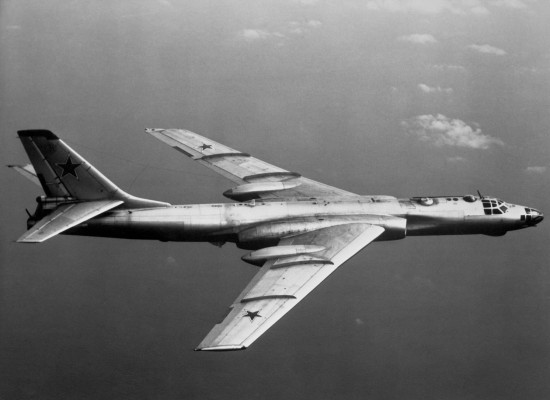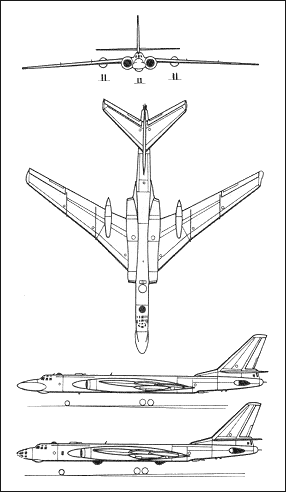|
||||||||||
|
|
||||||||||
|
||||||||||
|
|
||||||||||
 - -
 - -
 - -
|
|

|
Tupolev Tu-16 ASCC codename: Badger Intercontinental Strategic Bomber |
|
DESCRIPTION:
The Tu-16 was first seen by the public during the May Day military parade in 1954. About 2,000 of these versatile aircraft were built as strategic bombers, anti-shipping bombers, aerial refueling tankers, and reconnaissance aircraft. Production of the 'Badger' ended in about 1960 and the type was phased out of Russian service by about 1993. In addition to the Soviet Air Force and Navy, many Tu-16 survivors were inherited by former Soviet republics such as Ukraine and Belarus. All of these were retired during the mid-1990s. The Tu-16 was also exported to the Middle Eastern nations Egypt and Iraq. Several Iraqi planes were reportedly being loaded for a chemical weapon attack when they were destroyed on the runway during the Gulf War in 1991. The last of Iraq's Tu-16 fleet was destroyed during Operation Iraqi Freedom in 2003, and Egypt's Badgers were retired by 2000. The primary user still operating the Tu-16 is the Chinese Air Force flying a series of progressively updated H-6 bombers license-built by Xian. Some 150 H-6 bombers and derivatives modified for a variety of duties were built through the 1990s. About 120 are estimated to remain in service, and China has also restarted production of the modernized H-6M. A considerably updated H-6K carrying modern electronics and sophisticated cruise missiles is in development.
Data below for Tu-16K-11/16 |
|
| HISTORY: | |
| First Flight | 27 April 1952 |
| Service Entry | 1954 |
|
Retirement
|
(Russia) 1993
|
|
CREW:
|
six
|
|
ESTIMATED COST:
|
unknown
|
| AIRFOIL SECTIONS: | |
| Wing Root | PR-1-10S-9 (15.7%) |
| Wing Tip |
PR-1-10S-9 (12%)
|
| DIMENSIONS: | |
| Length | 114.17 ft (34.80 m) |
| Wingspan | 108.25 ft (32.99 m) |
| Height | 34.00 ft (10.36 m) |
| Wing Area | 1,770 ft² (164.7 m²) |
|
Canard Area
|
not applicable
|
| WEIGHTS: | |
| Empty | 82,010 lb (37,200 kg) |
| Normal Takeoff | 165,350 lb (75,000 kg) |
| Max Takeoff | 174,160 lb (79,000 kg) |
| Fuel Capacity |
internal: unknown external: unknown |
|
Max Payload
|
19,800 lb (9,000 kg)
|
| PROPULSION: | |
| Powerplant | two Mikulin AM-3M turbojets |
| Thrust |
41,840 lb (186.1 kN)
|
| PERFORMANCE: | |
| Max Level Speed |
at altitude: 652 mph (1,050 km/h) at 19,700 ft (6,000 m) at sea level: unknown cruise speed: 530 mph (850 km/h) |
| Initial Climb Rate | unknown |
| Service Ceiling | 49,200 ft (15,000 m) |
| Range |
typical: 3,135 nm (5,800 km) ferry: 3,890 nm (7,200 km) |
| g-Limits |
unknown
|
| ARMAMENT: | |
| Gun | up to seven NR-23 23-mm cannons with two each in remotely-operated dorsal and ventral turrets, two in a manned tail turret, and occassionally one mounted in the nose |
| Stations | one internal weapons bay and two external hardpoints |
| Air-to-Surface Missile |
(Tu-16) two KS-1 (AS-1 'Kennel'), one K-10S (AS-2 'Kipper'), or two KSR-5 (AS-6 'Kingfish') anti-ship
missiles; two KSR-11 (AS-2 'Kipper') or KSR-5P (AS-6 'Kingfish') anti-radar missiles (H-6) K-10S (AS-2 'Kipper'), KSR-5 (AS-6 'Kingfish'), C-601 ('Silkworm'), YJ-1/C-101 (CSSC-5 'Saple'), HY-3/C-301 'Sawhorse', YJ-62/C-602, or KD-88/C-802 (CSS-N-8 'Saccade') anti-ship cruise missiles |
| Bomb | various free-fall conventional or nuclear bombs |
| Other |
(Tu-16T) torpedoes, mines, depth charges
|
| KNOWN VARIANTS: | |
| Tu-16 'Badger-A' | First production model strategic bomber armed with conventional or nuclear free-fall bombs |
| Tu-16A 'Badger-A' | Nuclear bomber and one of the main production models, many of which were converted to other purposes; 453 built |
| Tu-16Z 'Badger-A' | Aerial refueling tanker using a wingtip hose to connect to the wingtip of another Tu-16, also retained a medium bomber capability |
| Tu-16N 'Badger-A' | Dedicated aerial refueling tanker fitted with a drogue system to support Tu-22 and Tu-22M bombers |
| Tu-16NN 'Badger-A' | Tu-16Z airframes converted to the Tu-16N configuration |
| Tu-16G 'Badger-A' | Fast air mail variant used for training of Aeroflot and mail-carrying crews also known as the Tu-104G |
| Tu-16T 'Badger-A' | Navy bomber based on the Tu-16A and armed with torpedoes, mines, or depth charges; 76 built |
| Tu-16S 'Badger-A' | Airborne lifeboat carrier converted from Tu-16T airframes and used for search and rescue operations |
| Tu-16Ye 'Badger-A' | Electronic warfare and electronic intelligence model |
| H-6, H-6A | Chinese conventional and nuclear bombers based on the Tu-16A license-built by Xian; approximately 120 built |
| Tu-16KS 'Badger-B' | Based on the Tu-16A but armed with two KS-1 air-to-surface missiles under the wings and carrying a guidance radar in the bomb bay, many later converted to carry free-fall bombs or updated missiles, operated by the Soviet Navy, Egypt, and Indonesia |
| Tu-16K-10 'Badger-C' | Soviet Navy anti-shipping bomber with a wider nose for an attack radar to guide a single K-10S anti-ship missile carried semi-recessed in the bomb bay; 216 built |
| Tu-16K-10-26 'Badger-C Mod' | Tu-16K-10 airframes converted to carry two KSR-2 or KSR-5 missiles, one under each wing, in addition to a K-10S |
|
Tu-16RM & Tu-16RM-1 'Badger-D' |
Tu-16K-10 airframes modified for maritime reconnaissance duties and equipped with several electronic intelligence gathering antennas and radomes, also retained the nose attack radar to guide K-10S missiles launched from other bombers; 23 converted |
| H-6B | Chinese reconnaissance variant of the H-6 |
| Tu-16R 'Badger-E' | Reconnaissance model similar to the 'Badger-A' with photography equipment placed in the bomb bay, could also guide KS-1 missiles |
| Tu-16RM-2 'Badger-E' | Modified Tu-16R used by the Soviet Navy that could also guide KSR-2 missiles |
| Tu-16KRM 'Badger-E' | Target drone launcher based on the Tu-16K-26 |
| Tu-16RM-2 'Badger-F' | Reconnaissance model based on the 'Badger-E' with underwing electronic intelligence pods |
|
Tu-16K & Tu-16KSR 'Badger-G' |
Soviet Navy bombers similar to the 'Badger-A' and able to carry bombs internally while also armed with KSR-2 or KS-5 missiles under each wing |
|
Tu-16KSR-2 & Tu-16K-16 'Badger-G Mod' |
Variants of the 'Badger-G' carrying two KSR-2 anti-ship missiles |
|
Tu-16K-11-16 & Tu-16KSR-2-11 'Badger-G Mod' |
Variant of the 'Badger-G' carrying two KSR-2 anti-ship missiles or two KSR-11 anti-radar missiles; about 440 converted |
|
Tu-16K-26 & Tu-16KSR-2-5-11 'Badger-G Mod' |
Anti-shipping bomber armed with two KSR-5 missiles and retaining the ability to carry KSR-2 or KSR-11 missiles and featuring a guidance radar between the engine inlets; over 240 converted |
| Tu-16KSR-2-5 'Badger-G Mod' | Conversion similar to the Tu-16K-26 or Tu-16KSR-2-5-11 but lacking the ability to carry the KSR-11 |
| Tu-16K-26P 'Badger-G Mod' | 'Badger-G' airframes designed to carry two KSR-5P anti-radar missiles while retaining the ability to carry the KSR-2, KSR-5, or KSR-11 |
| H-6C or H-6-III | Conventional bomber with improved countermeasures for self-protection used by the Chinese Air Force |
| H-6D or H-6-IV | Chinese anti-shipping bomber appearing in the early 1980s similar to the 'Badger-G' but carrying two C-601 'Silkworm' anti-ship missiles, updated versions can also carry two C-301 or four C-101 supersonic ant-ship cruise missiles |
| B-6D | Export version of the Chinese H-6D sold to Egypt and Iraq |
| HY-6 | Aerial refueling tanker retaining the ability to carry missiles |
| HY-6U or H-6U | HY-6 airframes modified to remove the fire control system and radar to become dedicated refueling tankers, also has a solid nose |
| HY-6D | H-6D airframes converted into aerial refueling tankers for use by the Chinese Navy except retaining a glass nose and fire control system allowing anti-ship missiles to be carried |
| HY-6DU | HY-6D airframes modified to remove the fire control system and used as dedicated refueling tankes by the Chinese Navy |
|
Tu-16P Elka or Tu-16PP 'Badger-H' |
Electronic countermeasures model equipped with chaff dispensers and used as to escort bombers |
|
Tu-16P Buket or Tu-16PP 'Badger-J' |
Electronic countermeasures model equipped with radar jammers |
| Tu-16Ye 'Badger-K' | Upgraded variant of the 'Badger-F' configured for electronic intelligence and reconnaissance |
| Tu-16PP 'Badger-L' | Upgraded version of the 'Badger-J' used for electronic warfare and electronic intelligence |
| H-6E | Chinese nuclear bomber model with improved countermeasures that was introduced in the 1980s |
| H-6F | H-6A and H-6C airframes upgraded during the 1990s with new inertial navigation systems, a navigation radar, and a GPS receiver and the last bomber model to be equipped with an internal weapon bay or defensive gun turrets |
| H-6G | Targeting platform appearing in the 1990s that provides guidance data to ground-launched cruise missiles, first model lacking an internal bomb bay or defensive weapons |
| H-6H | Land-attack model developed during the 1990s that carries two cruise missiles |
| H-6M | Cruise missile carrier with a terrain-following system and four weapon pylons under the wing, production restarted in 2006 |
| HD-6 | Electronic warfare model with a solid nose and canoe fairing covering electronic countermeasures systems |
| H-6K | New missile carrier equipped with larger and more powerful engines requiring larger air intakes plus a solid nose radome and redesigned flight deck |
| H-6I | Bomber prototype with a lengthened fuselage and fitted with four Rolls-Royce engines, two under the wings, used to demonstrate increased range |
| H-8I | Proposal for a new strategic bomber based on the H-6; not built |
| H-8II | Proposal for a more ambitious derivative of the H-6 powered by six engines spaced evenly along a larger span wing with an updated flight deck and solid nose; not built |
|
H-6 Launch Vehicle
|
Proposal for a solid-rocket-powered satellite launch vehicle to loft a 50-kg payload into orbit from an H-6
at an altitude of 33,000 ft (10,000 m); a mockup appeared in 2006
|
|
KNOWN COMBAT RECORD:
|
Six Days War (Egypt, Iraq, 1967) Yom Kippur War (Egypt, Iraq, 1973) Iran-Iraq War (Iraq, 1980-1988) Iraq - Operation Desert Storm (Iraq, 1991) Iraq - Operation Iraqi Freedom (Iraq, 2003) |
|
KNOWN OPERATORS:
|
Armenia (Armenian Air Force) Azerbaijan (Azerbaijan Air Force) Belarus, Voyenno Vozdushnyye Sily (Belarus Air Force) China, Zhongkuo Shenmin Taifang Tsunputai (People's Liberation Army Air Force) - Tu-16, H-6 China (People's Liberation Army Navy Air Force) - Tu-16, H-6 Egypt, Al Quwwat al Jawwiya il Misriya (Egyptian Air Force) - Tu-16, B-6 Indonesia, Tentara Nasional Indonesia - Angkatan Udara (Indonesian Air Force) Iraq, Al Quwwat Al Jawwiya al Iraqiya (Iraqi Air Force) - Tu-16, B-6 Russia, Voyenno Vozdushniye Sili (Russian Air Force) Russia, Aviatsiya Voyenno-Morskoyo Flota Sily Rossii (Russian Naval Aviation) Ukraine, Viys'kovo-Povitriani Syly Ukrayiny (Ukraine Military Air Forces) Union of Soviet Socialist Republics, Voyenno Vozdushniye Sili (Soviet Air Force) Union of Soviet Socialist Republics, Aviatsiya Voyenno-Morskoyo Flota (Soviet Naval Aviation) |
|
3-VIEW SCHEMATIC:

|
|
SOURCES:
|
|


|
Aircraft | Design | Ask Us | Shop | Search |

|
|
| About Us | Contact Us | Copyright © 1997-2023 | |||
|
|
|||